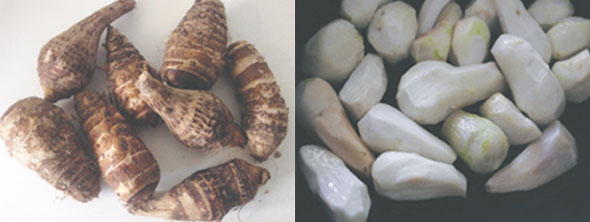Mama’s Punjabi Recipes: Arbi di Chaat (Eddoe Root Spicy Salad)
With summer just around the corner, there is a huge demand for quick, spicy light snacks. So, by popular demand, here is a reprint of Mama’s Arbi di Chaat recipe, which is just the kind of tasty, snack you need on hot afternoons. It is reprinted with some additional information and directions.
In the heat of the summer, when Punjabis want to snack, but not necessarily eat fried foods or potatoes, they reach out for arbi ki chaat which has a cool, spicy and tangy taste and is low in calories as it is not made with any oil. It is a simple and quick dish to make and is very satisfying. In India, many road food vendors make it for the people who go out for evening strolls.
Arbi (eddoe root) is closely related to the taro root but is smaller and has an acrid taste that requires careful cooking. It grows best in rich soil with good drainage but can also be grown in poorer soils and drier climates than the taro root. Eddoe originated in India and Malaysia, and from China and Japan it migrated to the West Indies and the New World.
All arbi dishes should be made with ajwain (bishop’s weed, carom seeds or ajwain caraway) as the spice coats the arbi to give it a unique taste and also is easy to digest. Among the benefits of arbi are that It reduces fatigue, aids in digestion, controls hypertension, has a low glycemic index making it good for diabetics, has amino acid and Omega-3 oils, builds immunity and slows the aging process. Arbi is high in carbohydrates, the vitamins E and pyridoxine, potassium and copper.
Ajwain is often taken with a pinch of salt (to cut the spice’s bitterness) and swallowed with a glass of water for stomach ache or indigestion. Ajwain is a seed that smells almost exactly like thyme but is more aromatic, slightly bitter and pungent and stronger in taste. A favorite in many Punjabi households is a crispy, hot, namak-mirch-ajwain parontha (flaky bread) eaten with a small wad of homemade white makhan (butter).
Ingredients:
• 2 lbs arbi (small to medium eddoe root)
• 2 large nimbu (lemons) – cut in halves
• 1 large piyaaz (onion) – peeled and chopped into small pieces
• 1 medium adrak (ginger root) – peeled and chopped into small pieces
• 2 large hari mirch (green chillies) – chopped into small pieces
• 1 tsp ajwain (bishop’s weed or carom seeds)
• 1 tsp amchoor (dry mango powder)
• Spices (to taste): namak (salt), mirch (red pepper), garam masala
Directions:
1. Wash the arbi then place it in a pot and boil. Remove when still hard and not too tender.
2. Peel the arbi and cut into small pieces.
3. Place the cut arbi in a large bowl, then add the onions, ginger, chillies and all the spices. Squeeze the juice out of the lemons over the mixture. You can also use bottled lemon juice instead of fresh lemons.
4. Stir the mixture thoroughly and then chill in the fridge for 30 minutes before serving.
5. Some people enjoy this dish with some imbli (tamarind) chutney.
MAMA’S TIP OF THE WEEK: EASY WAY TO CLEAN SILVER WITH TARNISH REMOVER
One of the downsides of having silver (or silver-plated) cutlery, ornaments or decoration pieces is that, over time, when exposed to humid air, they will oxidize and become coated with a brownish tinge. After awhile, the pretty silver items start to look ugly and need to be polished. If you use and wash them daily, then the items do not tarnish, but polishing still makes them shine.
There are a variety of silver polishes and some people even suggest using toothpaste, but these always require lots of scrubbing, which is a tedious task. Also, you can’t get to the little creases and carved spaces. It’s much easier if you use a product like Tarn-X, which is a liquid. Just pour a small amount into a wide open flat bowl, then use a small spoon to drip the liquid over the silver surface. The tarnish will immediately disappear and the silver luster will show. Just wash with soap and water and then dry with a soft cloth.

Shakuntla Malhotra is a skilled cook of Punjabi dishes made in the old-fashioned style that she learnt as a young woman in her ancestral home in Lyallpur, India (since renamed Faisalabad) before it became part of Pakistan after the Partition in 1947. People have often admired her cooking for its simplicity and taste that comes with each mouthful. Even in her late-eighties, she continues to cook daily and agreed to share her delectable Punjabi vegetarian recipes for future generations.


